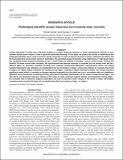| dc.contributor.author | Danos, N. | |
| dc.contributor.author | Lauder, George V. | |
| dc.date.accessioned | 2017-03-06T19:17:29Z | |
| dc.date.issued | 2012 | |
| dc.identifier.citation | Danos, N., and G. V. Lauder. 2012. Challenging Zebrafish Escape Responses by Increasing Water Viscosity. Journal of Experimental Biology 215, no. 11: 1854–1862. doi:10.1242/jeb.068957. | en_US |
| dc.identifier.issn | 0022-0949 | en_US |
| dc.identifier.uri | http://nrs.harvard.edu/urn-3:HUL.InstRepos:30510349 | |
| dc.description.abstract | Escape responses of fishes have long been studied as a model locomotor behavior in which hypothesized maximal or nearmaximal muscle power output is used to generate rapid body bending. In this paper we present the results of experiments that challenged zebrafish (Danio rerio) to perform escape responses in water of altered viscosity, to better understand the effects that the fluid mechanical environment exerts on kinematics. We quantified escape kinematics using 1000framess–1 high-speed video, and compared escape response kinematics of fish in three media that differed in viscosity: 1mPas (normal water), 10mPas and 20mPas (20 times normal water viscosity). We hypothesized that because viscosity is increased but not density there will be a different effect on kinematic variables resulting from unsteady (acceleration-dependent) hydrodynamic forces and steady (velocity-dependent) ones. Similarly, we hypothesized that the kinematics of stage 1 will be less affected by viscosity than those of stage 2, as higher angular velocities are reached during stage 1 resulting in higher Reynolds numbers. Our results showed a significant overall effect of viscosity on escape response kinematics but the effect was not in accordance with our predictions. Statistical tests showed that increasing viscosity significantly decreased displacement of the center of mass during stage 1 and after 30ms, and decreased maximum velocity of the center of mass, maximum angular velocity and acceleration during stage 1, but increased time to maximum angular acceleration and time to maximum linear velocity of the center of mass. Remarkably, increasing water viscosity 20 times did not significantly affect the duration of stage 1 or stage 2. | en_US |
| dc.description.sponsorship | Organismic and Evolutionary Biology | en_US |
| dc.language.iso | en_US | en_US |
| dc.publisher | The Company of Biologists | en_US |
| dc.relation.isversionof | doi:10.1242/jeb.068957 | en_US |
| dash.license | LAA | |
| dc.subject | locomotion | en_US |
| dc.subject | fish | en_US |
| dc.subject | viscosity | en_US |
| dc.subject | zebrafish | en_US |
| dc.title | Challenging zebrafish escape responses by increasing water viscosity | en_US |
| dc.type | Journal Article | en_US |
| dc.description.version | Version of Record | en_US |
| dc.relation.journal | Journal of Experimental Biology | en_US |
| dash.depositing.author | Lauder, George V. | |
| dc.date.available | 2017-03-06T19:17:29Z | |
| dc.identifier.doi | 10.1242/jeb.068957 | * |
| dash.contributor.affiliated | Lauder, George | |


